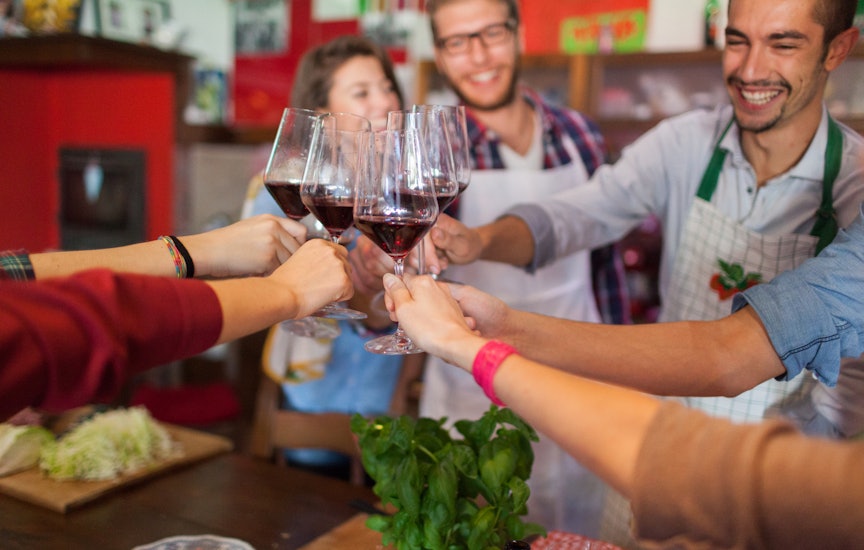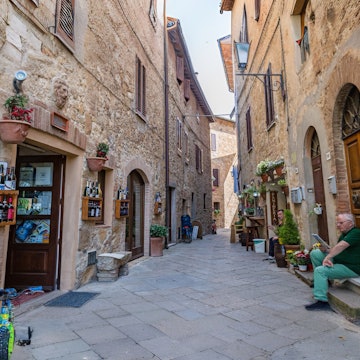

The rolling hills of the Langhe region are carpeted with vineyards. StevanZZ / Shutterstock
With some of Italy’s best wines, truffles, beef and chocolate, the northern Italian region of Piedmont offers a plethora of exhilarating tasting experiences. The capital Turin’s palaces and post-industrial warehouses are home to edgy contemporary art and world-class DJs, while friendly Alpine ski resorts and tranquil hiking trails are just an hour away.
Elegant and cultured, rustic, real and wild: Piedmont pleases on all fronts.
Wander the vineyard trails of the Langhe
From a gentle morning ramble around the Nebbiolo-lined hills that circle Barbaresco, to a dedicated four-day circuit taking in Alba, Barolo and villages in between, walking is one of the best ways to experience the sublimely pretty landscapes and taste the much sought after wines of the bucolic Langhe region. Multi-day routes will also take you through hazelnut groves and the wilder, forested Alpine foothills. Accommodation ranges from simple farm stays and village B&Bs to grand palazzos or modern-luxe mini-resorts like Arborina Relais. Route maps are available from the tourist office in Alba, as well as from the Enoteca Regionale (wine co-ops) in each village.
Explore Rivoli’s world-class contemporary art collection
The soaring, frescoed reception rooms of the Castello di Rivoli form a unique and breathtaking backdrop to a collection of artworks that inspires the envy of curators in Milan, Rome and Venice. The hilltop Savoy stronghold has some exceptional examples of Italy’s own Arte Povera as well as pieces from the edgier 20th-century movements like Transavanguardia, Minimal, Body and Land Art. Local contemporary bad boys Maurizio Cattelan and Francesco Vezzoli get pride of place, and a more traditional white cube extension houses temporary shows. Rivoli’s latest acquisition is the near-mythical Cerruti collection, some of which will be featured at the castle, while other works will remain in situ at the reclusive collector’s villa nearby. These include a staggering number of di Chiricos, many works by other 20th-century Italian artists such as Boccioni, Balla and Fontana, as well significant paintings by Renoir, Modigliani and Kandinsky, to name a few.

Surrender to truffle fever in Alba
Celebrity chefs, giddy gourmets and high-rolling restaurateurs, as well as throngs of truffle-loving locals, descend upon the normally laid-back (if perpetually food-obsessed) town of Alba on October weekends. Officially known as the Fiera Internazionale di Tartufo Bianco d’Alba, the cashed-up come from far and wide to seek out the biggest and best of the musky white nuggets at the weekly auctions, while the town’s numerous alimentari are stocked with smaller, more affordable truffles and truffle-laced oil, honey, pasta and sauces. Truffle-flecked dishes are ubiquitous at restaurants too; an ever-reliable option is stylish, friendly La Piola, set on the cobbled square next to the Duomo. During truffle season their famous tajarin pasta is served with just a slick of butter ready for truffles to be shaved to order (priced by weight – it’s up to you to temper your own truffle lust).
Meet the mummies at Turin’s Egyptian Museum
Turin's Museo Egizio – housing the most important collection of Egyptian treasures outside Cairo – dates back to 1824 and the birth of modern archaeology. Its most recent incarnation, however, is a slick, dramatic museum experience where contemporary interpretive techniques meet an incredible number of priceless artefacts. Among the many highlights are a statue of Ramses II, one of the world's largest papyrus collections (including millennia-old erotica), and funerary and domestic items from the 1400 BC tomb of royal architect Kha and his wife Merit. The gold-leaf and glass rendering of Merit’s portrait on her cartonnage sarcophagus is possibly the world’s most beautiful.

Power across the powdery slopes of Via Lattea
Seven resorts share some 400km of runs on the ‘Milky Way’, a gentle Alpine wonderland just over an hour from Turin. While Sauze d’Oulx has long been a destination for après-loving Brits, Torinese families and serious skiers, especially high-mileage intermediates, favour Sestriere and Mota. They’re known for their good reds and blacks, while heli-skiing and guided off-piste skiing can be done in the Upper Susa Valley. Snowboarders head to Sestriere too, but there are better facilities in (unlinked) Bardonecchia. The valley town of Susa is often just a supply stop for skiers keen to get to the resorts, but the once important Roman city is worth a further detour to visit its handsome 1st-century BC gate, not far from the centre. You can also pop over into France – Montgenèvre’s reliable snow and family-friendly runs are also covered by Via Lattea pass.
Drink in Turin’s unique after-dark mix
It comes as no surprise that the home of vermouth – the herbal fortified liquor was invented in Turin in 1786 – also claims the Italian aperitivo tradition as its own. Origin stories aside, the city’s pre-dinner scene is a diverse and bountiful one, from traditional snack buffets at historic cafes like Caffè San Carlo or Caffè Torino, to an upmarket, sit-down spread at moody Bar Cavour, or one of the student-friendly and carb-loaded bars of San Salvario or Piazza Filiberto. However, Turin’s booming natural-wine and small-plate dining scenes provide a reason not to fill up too soon, with restaurants like Gaudenzio and Banco vini e alimenti reinventing dishes and menu formats with bold verve as well as deep respect. After midnight, the neighbourhoods of Vanchiglia, Aurora, San Salvario, Dora and Lingotto are home to bars, clubs and live venues. Turin produces at least half of Italy’s best dance music and it's in these industrial or largely residential zones that you’ll find it. The Club to Club festival, held in November at the Lingotto Fiere is a yearly music-scene highlight that features both international and Italian New Wave acts.
Savour the Savoy splendour at the Reggia di Venaria Reale
A hunting lodge it may well be, but this sprawling, ostentatious baroque beauty, built for the Duke of Savoy, Carlo Emanuele II in 1675, rivals Versailles in its royal bling, architectural ambition and sheer scale. Wear comfortable shoes: the main exhibition, aptly-named 'Theatre of History and Magnificence', is a 2km-long audio-visual journey care of Peter Greenaway and Brian Eno that tells the millennia-long history of the Savoy clan in their former residential quarters. The palace's vast gardens are a wonderful place for a picnic in warm weather, but also ridiculously atmospheric cloaked in winter snow.

Gaze across the glassy waters of Lake Orta
Circled with deep woodlands, Lake Orta is a supremely tranquil place for a day trip. Swim in or sail on the lake, hike its surrounding spruce and chestnut forests, or simply laze lakeside. In the pretty medieval town of Orta San Giulio you can wander the tangle of steep narrow streets or take a ferry over to Isola San Giulio to breathe in the incense at the tiny island's 12th-century basilica. And while nearby Lake Maggiore’s Stresa draws Hemingway fans (parts of A Farewell to Arms were set there), Orta has its own literary claims to fame: Nietzsche may or may not have kissed Lou Salome up at Sacro Monte di San Francesco, and Robert Browning penned 'By the Fire-Side', one of his most tender poems, here.

Hike the craggy, wild terrain of the Maritime Alps
Prepare yourself for a sense of remote isolation when striking out in these moody and majestic peaks and valleys that straddle the border with France. Old mule trails, military passes and dedicated hiking paths traverse limestone canyons, grasslands, high altitude lakes and perennial snow fields. The Parco Naturale Alpi Marittime offers up an amazing array of botanical life, as well as chance sightings of ibex, chamois, wild sheep and numerous eagles and other birds of prey. Down in the valley, many of the grey-stone and dark-timber villages have become depopulated since the 1960s, but historic Aisone has reinvented itself as a cross-country ski centre and keeper of local Occitan musical traditions.
Tempt your sweet tooth in Cuneo
A few centuries back, a canny Piedmontese came up with the brilliant idea to combine the plentiful local hazelnuts with cocoa, an expensive and occasionally scarce import, inventing the moreish gianduiotto chocolate, along with the soft and spreadable gianduja, which would eventually come to seduce the world as Nutella. Chocolate has long been big business in the province of Cuneo, which is Italy’s largest producer. But artisan traditions have also been preserved in the region’s small, stately capital, also called Cuneo. The city has spectacular Alpine views, excellent steak restaurants, an autumn chestnut festival and a progressive green ethos, but no one will be surprised if you admit you’ve actually come solely to sample its signature cuneesi al rhum chocolates, a dark heady rum-scented truffle still made to the original recipe at the piazza-side Pasticceria Arione.
Get more travel inspiration, tips and exclusive offers sent straight to your inbox with our weekly newsletter.
https://shop.lonelyplanet.com/products/lonely-planets-best-in-travel-paperback-2019















